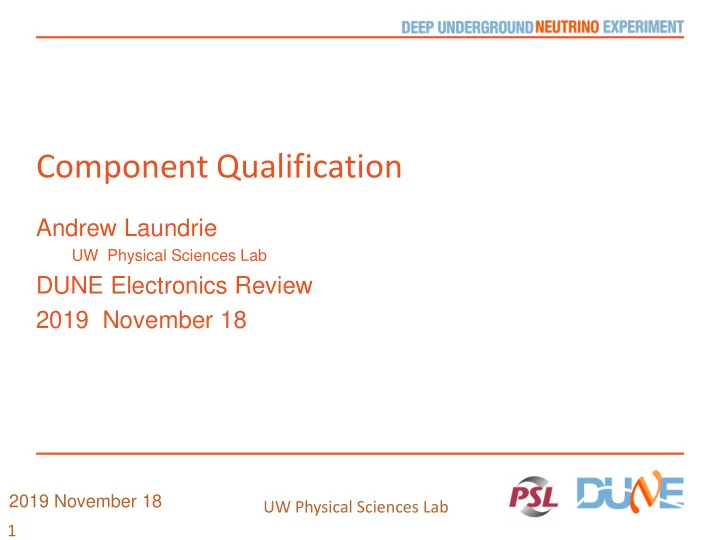

Component Qualification Andrew Laundrie UW Physical Sciences Lab DUNE Electronics Review 2019 November 18 2019 November 18 UW Physical Sciences Lab 1
Cold-Test Methodology • Select components having a good chance of surviving temperature extremes • Mount components on a test vehicle • Measure characteristics at room temperature and at Liquid Nitrogen temperature • Repeat temperature cycles 2
Cold-Tested Components • Multi-Layer SMT Ceramic Capacitors • Thick-Film SMT Resistors • Bias Connectors • Mill-Max Receptacles 3
Component Selection • Research options having necessary specs • Only evaluate components rated for -55C • Study component structure and materials • Read manufacturer’s process guidelines 4
Capacitor Choice • Kemet part number C2225X392JGGACTU • 3.9 nF +/- 5% C0G (NP0) 2 kV Surface Mount • Usable for all coupling and filter functions • High immunity to flex cracks • Pliable silver epoxy between the base metal and nickel barrier layers of the termination system. • Inhibits the transfer of board flex stress to the rigid ceramic body 5
Capacitor Construction 6
Capacitor Cold Test Fixture 7
Capacitor Cold Test Results • 42 Samples tested hot and cold, five cycle • Room temperature: 3.79 to 4.02 nF (+/- 0.5%) • In liquid nitrogen: All increased ~0.02 nF • No changes over five temperature cycles • No leakage currents exceeded 0.1 nA at 1 kV 8
Resistor Choice • Bourns CHV Series Thick Film High Voltage Chip Resistors (rated for -55C) • CHV2010 Package: 2000 Volts • Reliable for UL/IEC safety certifications • Tolerance +/- 1% for 5 or 10M, +/- 5% for 51M 9
Resistor Cold Test Results • 21 Samples of 51M tested hot and cold (x5) • Room temperature: 48.8 to 52.0 (+/- 2%) • In liquid nitrogen: Increased by 1.5 to 1.9 • 21 Samples of 4.7M tested hot and cold (x5) • Room temperature: 4.69 to 4.71 (+/- 0.2%) • In liquid nitrogen: Increased by 0.15 to 0.16 • No changes seen over five temp. cycles 10
Bias Connector Choices • Phoenix Contact 1808190 SMT receptacle • Phoenix Contact 1778832 plug • No temperature range given, only hot derating • Body material is a Liquid Crystal Polymer • Same class of material used in Samtec parts • Contact resistance measured warm and cold • Mating forces measured warm and cold 11
Bias Connector Cold Test Results • Room-temperature mating and removal forces: 1 to 2 pounds • Liquid Nitrogen mating and removal forces: 1.5 to 2.5 pounds • Change in contact resistance: none seen 12
Mill-Max Board-to-Board Connectors • ProtoDUNE components were off-the-shelf • Mechanical stability problems were not recognized early enough to explore options for customized components • Mechanical stability was enhanced using 3M 2216 Clear epoxy • Components were tested warm and cold to ensure good electrical performance 13
M-M Connector Cold Test Results • 200 mated components were mounted in a head board stack and connected in series • Most of the combined resistance was contributed by jumper wires and on-board wire traces • A four-wire Ohm-meter measured combined resistance repeatable to +/-0.002 Ohms • After 10 temperature cycles, no change in combined resistance value 14
Mill-Max Board-to-Board Connectors • DUNE uses custom designs • Mechanical stability was thoroughly tested at room temperature • Mechanical stability is assured for an acceptable range of through-hole diameters • Components were tested warm and cold to ensure good electrical performance 15
M-M Connector Cold Test Results • 160 mated components were mounted in a head board stack and connected in series • After 10 temperature cycles, no change in combined resistance value was noted • Total resistance was continually monitored during temperature transitions to detect any intermittent contact (same as for ProtoDUNE) • More testing using larger arrays is planned 16
Backup Slides 17
Recommend
More recommend